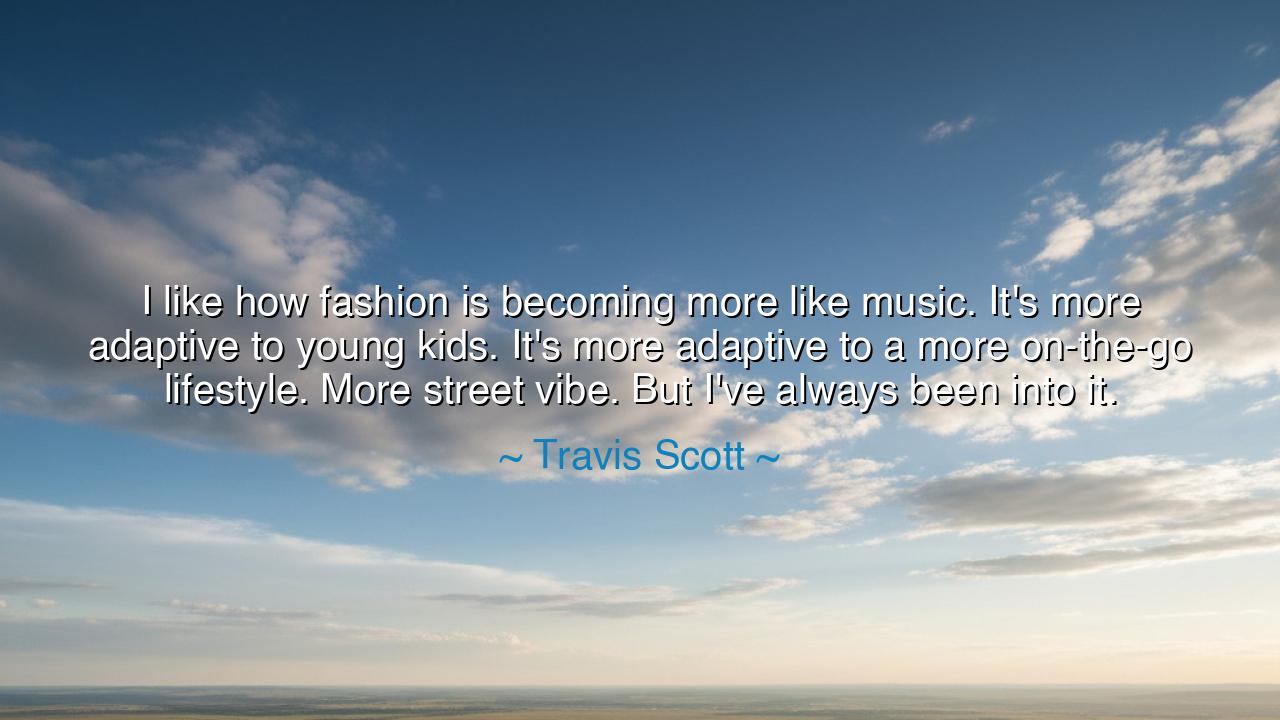
I like how fashion is becoming more like music. It's more
I like how fashion is becoming more like music. It's more adaptive to young kids. It's more adaptive to a more on-the-go lifestyle. More street vibe. But I've always been into it.






Hear, O seekers of wisdom and style, the words of the modern bard, Travis Scott, who declared: “I like how fashion is becoming more like music. It’s more adaptive to young kids. It’s more adaptive to a more on-the-go lifestyle. More street vibe. But I’ve always been into it.” This is not merely a remark about garments and beats—it is a proclamation about the changing soul of culture itself. In these words, Travis speaks of a uniting power, where fashion no longer stands apart as lifeless fabric, but moves with rhythm and pulse, much like music, alive, breathing, reshaping itself to meet the needs of the restless generation.
What does it mean, that fashion is becoming like music? Consider this: music has always been the most immediate language of the spirit. It adapts, it evolves, it bends with the voices of youth, it rises and falls with the heartbeat of the streets. So too, says Travis, must fashion become—a mirror of life that is not stiff, not trapped in museums or high palaces, but alive among the people, reflecting their struggles, their triumphs, their hunger for expression. To clothe oneself, then, is not merely to cover the body—it is to wear the rhythm of the age upon one’s skin.
Indeed, history has shown us this truth. Recall the Jazz Age of the 1920s, when music shattered old traditions and the young abandoned the corsets and coats of their parents. Women cut their hair short, men loosened their ties, and the world swayed to the sound of the saxophone. In those days, fashion and music danced together, breaking barriers, giving voice to rebellion and freedom. The Charleston was not just a dance; it was a movement, and the flapper dress was its banner. Just as Travis Scott observes today, fashion once again bends to the rhythms of life, adapting to speed, to freedom, to the voices of the streets.
And what is this street vibe he speaks of? It is authenticity, it is the unpolished truth of culture born not in boardrooms but on corners and sidewalks. It is the sneaker scuffed from running, the hoodie that shields against both cold and judgment, the cap turned low in defiance. From the asphalt comes a wisdom the high towers cannot create: a wisdom of survival, of creativity born in scarcity, of community forged in struggle. When fashion bows to this street vibe, it bows to truth itself—the truth that culture is made by the people, not imposed upon them.
Travis also speaks of adaptiveness, the power to shift, to remain alive in a world that no longer waits. Just as youth today move fast—through cities, through screens, through dreams—so must their style move with them. Clothes are no longer ornaments for the ballroom; they are armor for the street, wings for the restless, identity stitched into fabric. Like music, which can be carried in pockets and streamed into the soul at any moment, so too must fashion be ready to travel, to shift, to empower.
But within his words is also confession: “I’ve always been into it.” This is the mark of the true artist, who recognizes that art is not separate silos but one great river with many streams. For him, fashion is not an accessory to music, but its brother. Just as the beat can set the crowd aflame, so too can a look ignite a movement. Travis reminds us that those who truly understand culture see its parts not as fragments, but as one body. To shape music is to shape style; to shape style is to shape life.
What lesson then must we, the listeners of these words, take to heart? It is this: do not treat fashion as vanity, nor music as noise, but see in them the eternal languages of expression. Let your clothing, your art, your life, reflect your truth. Do not be bound by rigid forms; be adaptive, be alive, be ready to express who you are in every step, in every note, in every thread. For culture belongs not to the past, but to those who dare to shape the present.
So, let each of us take action. Dress not to hide, but to declare. Create not to conform, but to inspire. Carry yourself as one who knows that every color, every sound, every choice is a message written upon the canvas of the world. Walk as if your steps carry a rhythm, live as if your life wears an exclamation point, and remember always: like music, your style must sing.






AAdministratorAdministrator
Welcome, honored guests. Please leave a comment, we will respond soon